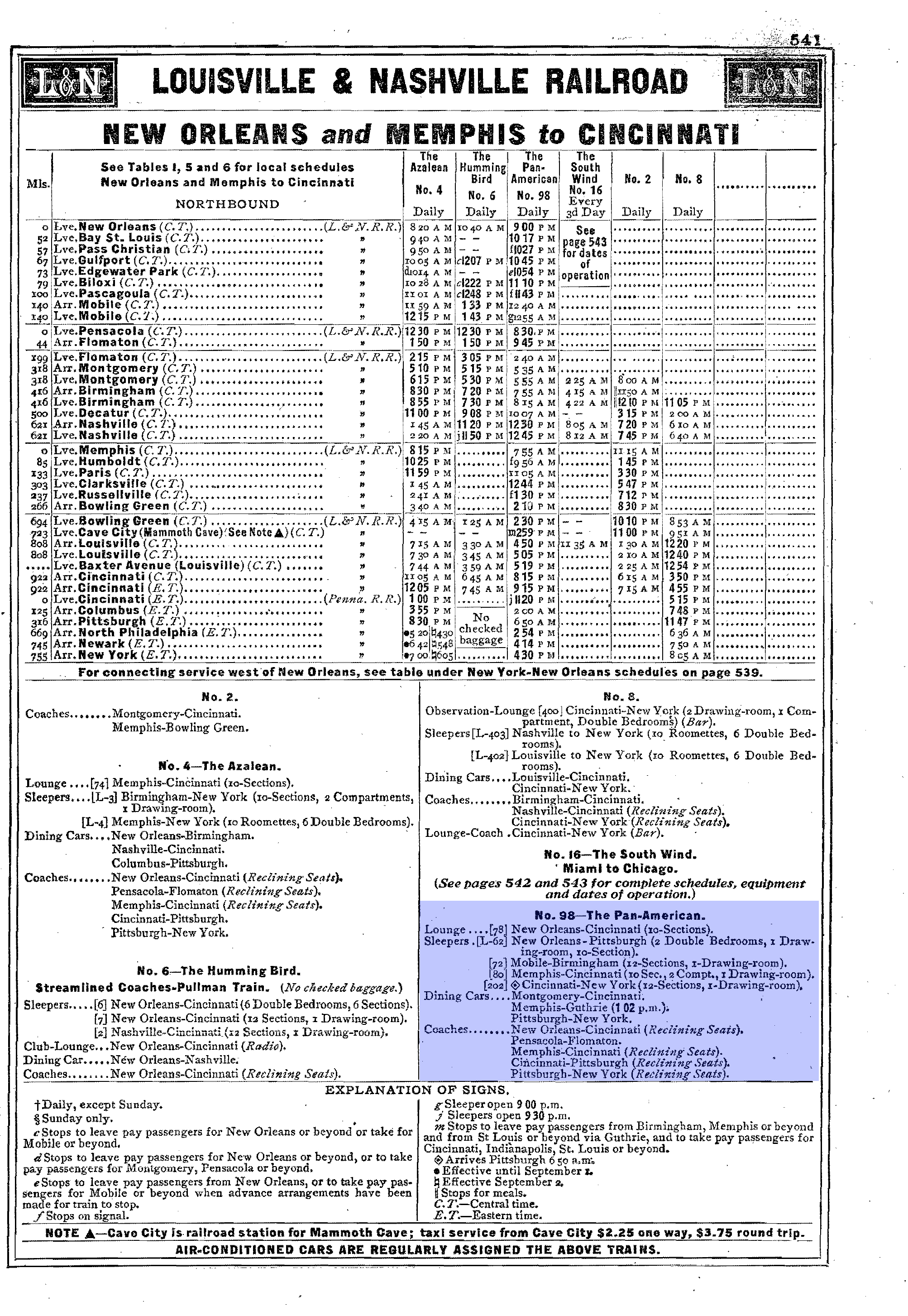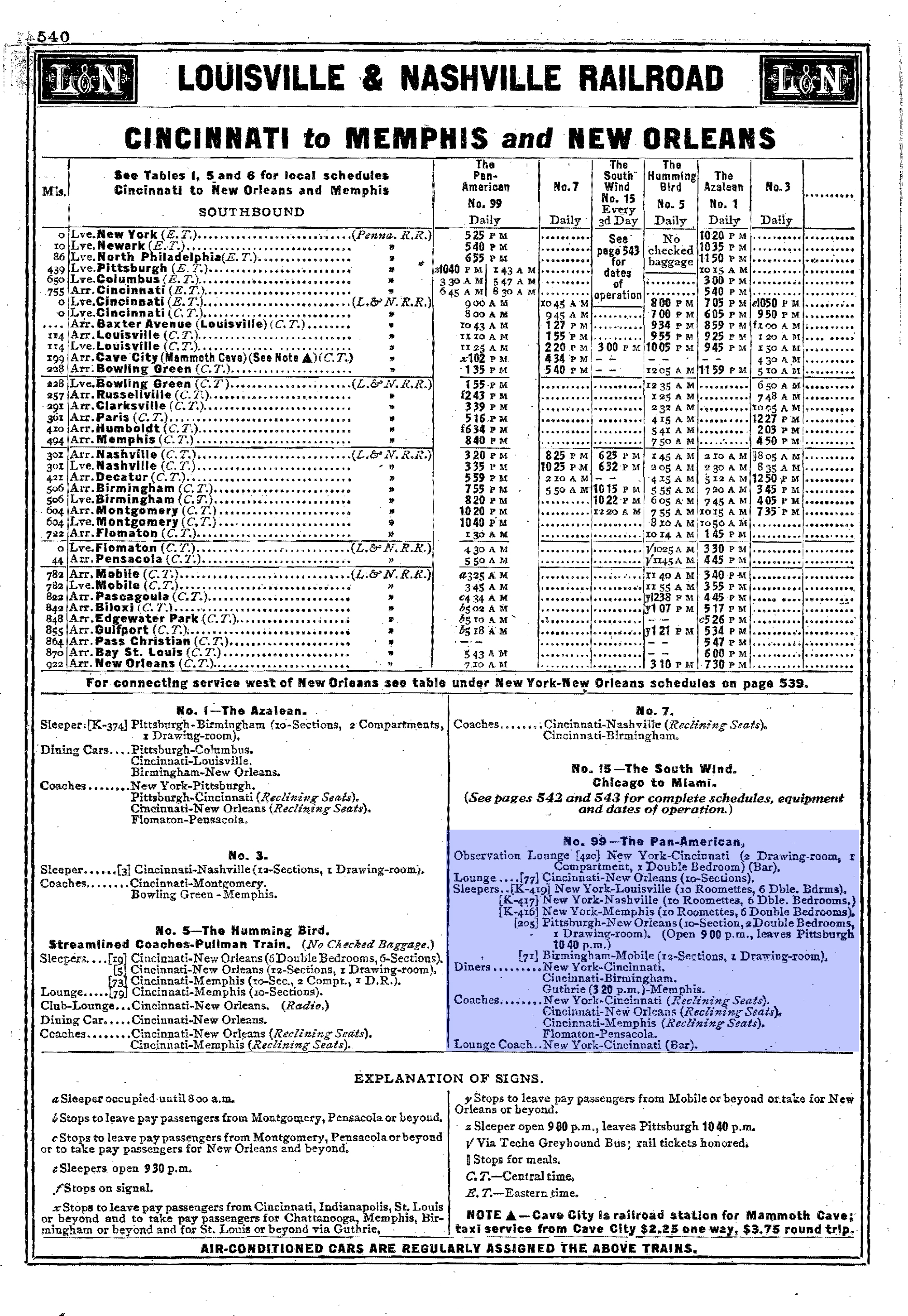"Pan American" (Train): Route, Schedule, Consist
Last revised: February 25, 2025
By: Adam Burns
The Louisville & Nashville is not well remembered for its passenger
services although one of its top trains within its fleet was the Pan American,
a fairly successful run for several years although officially never
entirely streamlined (it was, however, upgraded with various equipment
throughout its years of operation).
While most of L&N’s passenger trains were dropped or canceled prior to the creation of Amtrak in the spring of 1971, the American, remained until the end ceasing operations on April 30, 1971 one day prior to Amtrak’s startup.
The railroad's interest in passenger service waned significantly after the 1950's. It was similar to the Southern Pacific, which held the same view of such trains after that time.
In spite of this, the L&N continued fielding respectable service until the end (the same could not be said at SP). The Pan American inspired several songs including "Pan-American, Blues" by DeFord Bailey, "The Pan-American," by Hank Williams, and "Pan-American, Boogie" by the Delmore Brothers.
Photos
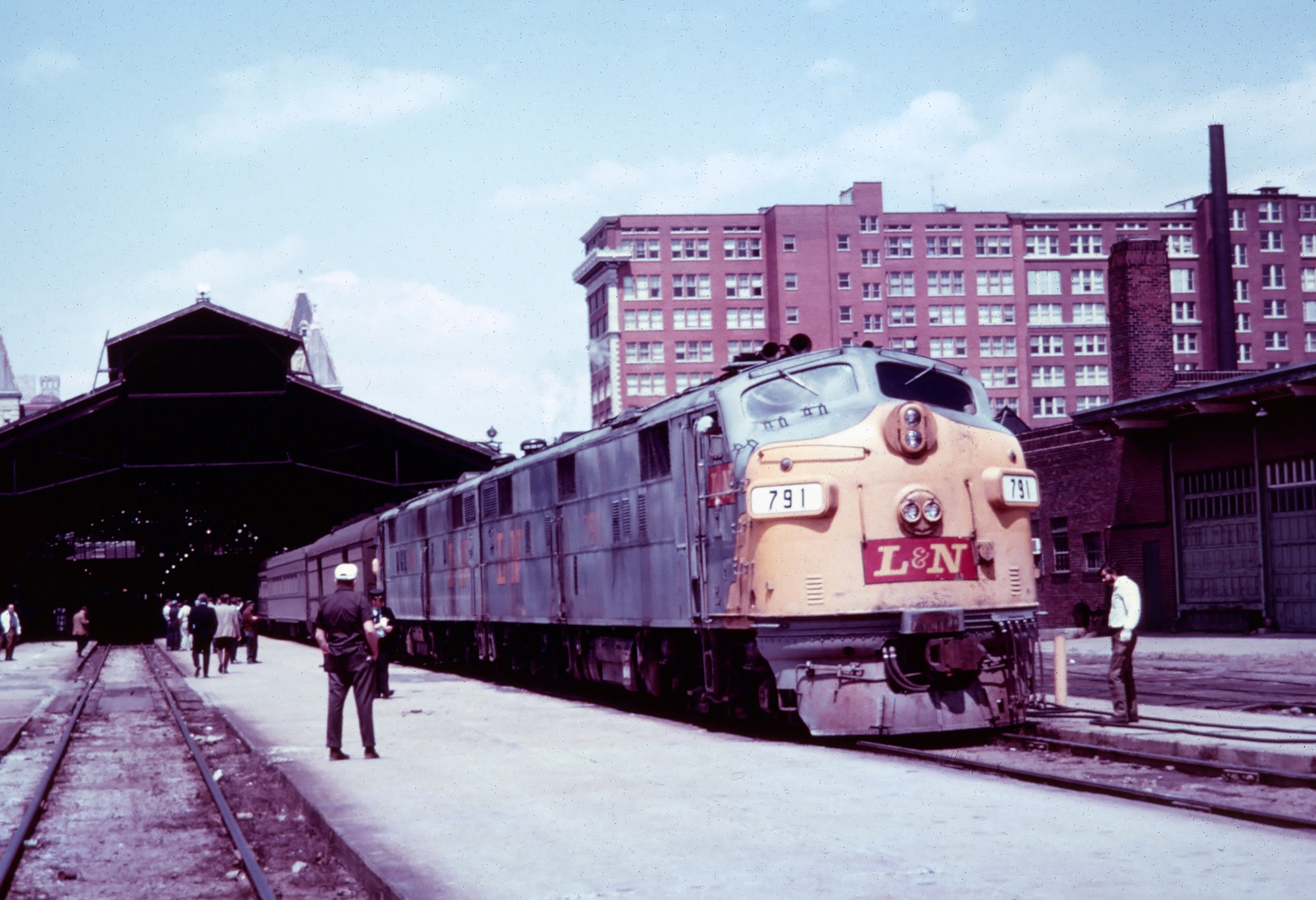 Folks have gathered around the final run of Louisville & Nashville's "Pan American," led by E7A #791, awaiting departure from Louisville Union Station on May 1, 1971. American-Rails.com collection.
Folks have gathered around the final run of Louisville & Nashville's "Pan American," led by E7A #791, awaiting departure from Louisville Union Station on May 1, 1971. American-Rails.com collection.History
The Pan American, (named because of the service Louisville & Nashville provided hauling Central and South American goods through Gulf Coast ports) began as a heavyweight operation in 1921 serving Cincinnati and New Orleans as the railroad's flagship train.
It lost this status in 1947 when the L&N debuted the all-streamlined Humming Bird. Beginning in 1949 the L&N slowly updated the train with older, streamlined equipment (which also included new streamlined sleepers for through service between New York and Memphis/Louisville/Nashville in conjunction with the Pennsylvania).
In 1953 it again received some additional new, through sleepers and in
1955 began occasionally swapping older and new equipment with the Humming Bird.
For power the train originally used Electro-Motive E6As, later
upgrading to EMD E7As between 1945 and 1949.
At A Glance
23 Hours, 10 Minutes (Southbound) 23 Hours, 15 Minutes (Northbound) |
|
99/9 (Southbound) 98/8 (Northbound) | |
Union Terminal (Cincinnati) Canal Street/Union Passenger Terminal (New Orleans*) |
* From 1902 - 1954, the L&N used its own terminal in New Orleans at Canal Street. In 1954, Union Passenger Terminal opened which consolidated all intercity passenger services.
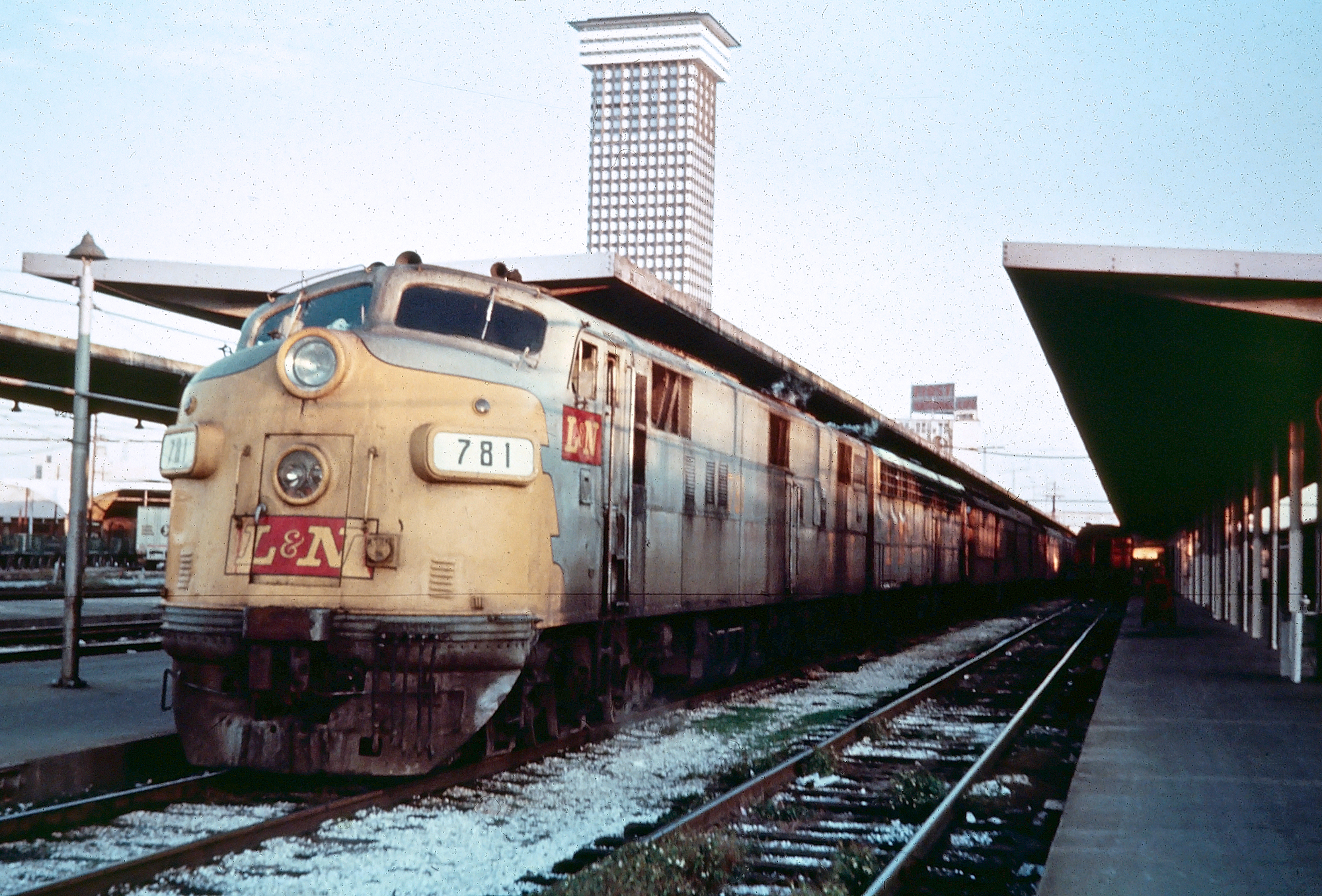 Louisville & Nashville E7A #781 awaits departure from New Orleans with the late era "Pan American" in February, 1970. American-Rails.com collection.
Louisville & Nashville E7A #781 awaits departure from New Orleans with the late era "Pan American" in February, 1970. American-Rails.com collection.Finally, in 1951 the L&N purchased E8As for passenger service. Interestingly, the railroad never used "B", booster units, which at the time was typically a common practice for a Class I's flagship (it allowed for additional power without the need for an additional cabbed locomotive).
The train was a quite successful operation although because it competed in a market dominated by the Illinois Central with its Panama Limited, and City of New Orleans, the American, was often overshadowed.
Still, for over five decades it provided reliable, efficient, and friendly service between the Gulf Coast and Midwest even if it was not a fully-equipped streamliner like some of the other runs serving both cities.
Listed for years as trains #99 (southbound) and #98 (northbound) on the
L&N timetable in its final days the train was changed to #9 and #8 respectively.
Timetable (1952)
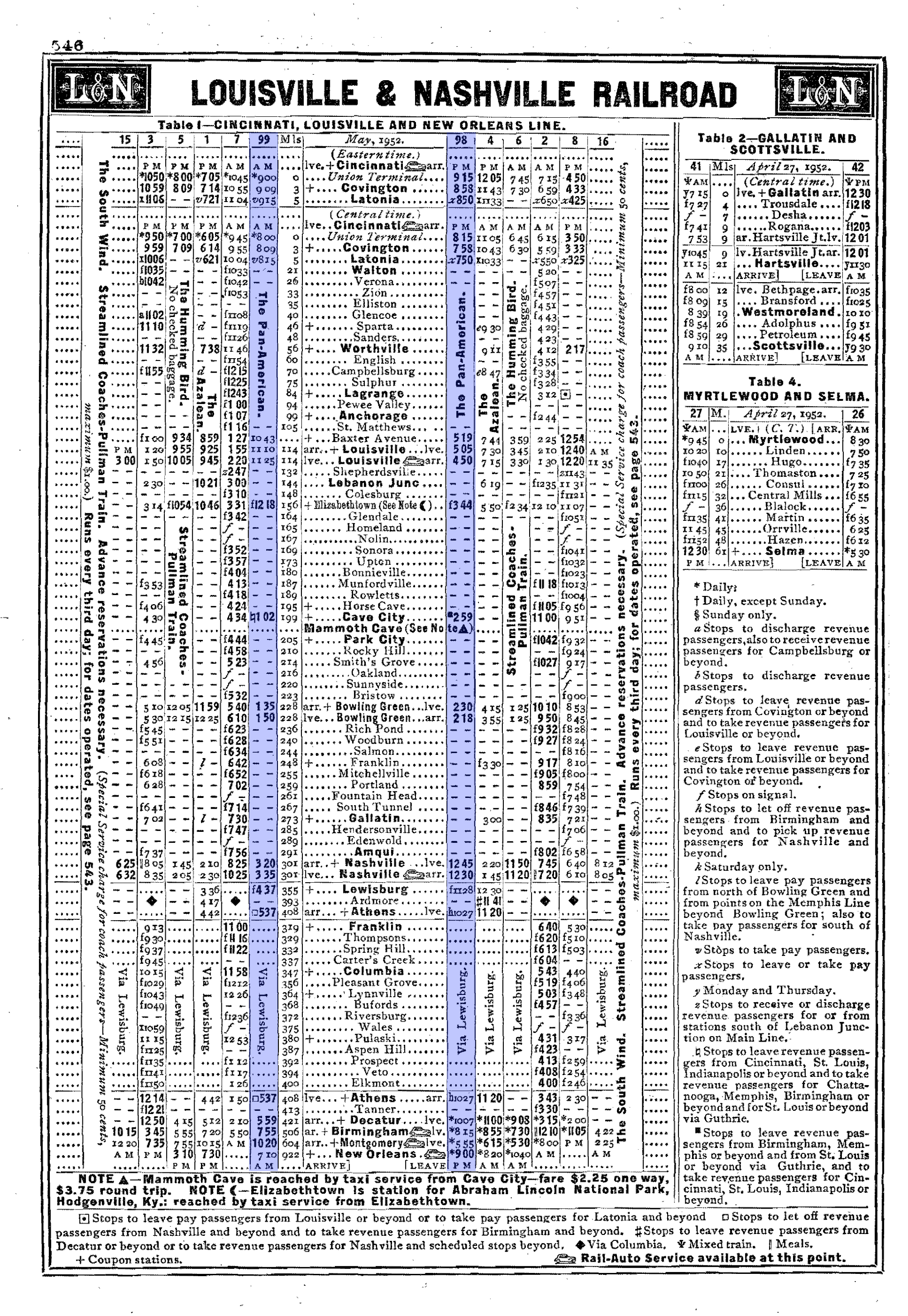
Essentially the American was a less luxurious version of the Humming Bird, which offered opulent dayliner services including reclining-seat coaches and lounges.
As with all of the Louisville & Nashville's original passenger fleet, the train's locomotives were originally bedecked in L&N's handsome deep blue and cream with red trim while the cars featured a combination of deep blue and stainless steel.
Consist (1952)
In later years the railroad changed this to a more simple general livery of grey, yellow, and red for all its equipment, including freight.
While the passenger trains still carried a level of good looks the new paint scheme was simply not as elegant as the original. In 1955 the American received additional newer equipment when the L&N purchased 13 new coaches to reequip it and the Humming Bird. It was also given a rebuilt, streamlined lunch-counter lounge in 1957.
Timetable (1969)
| Read Down Time/Leave (Train #9) | Milepost | Location | Read Up Time/Arrive (Train #8) |
|---|---|---|---|
| 12:20 PM (Dp) | 0.0 | 5:35 PM (Ar) | |
| F 12:35 PM | 3 | F 5:15 PM | |
| 3:35 PM (Ar) | 114 | 2:25 PM (Dp) | |
| 4:05 PM (Dp) | 114 | 2:00 PM (Ar) | |
| F 3:59 PM | 156 | F 11:49 AM | |
| 4:42 PM | 199 | 11:08 AM | |
| 5:19 PM | 228 | 10:39 AM | |
| 7:00 PM (Ar) | 301 | 9:10 AM (Dp) | |
| 7:20 PM (Dp) | 301 | 8:50 AM | |
| 8:25 PM | 355 | 7:36 AM | |
| 9:21 PM | 408 | 6:41 AM | |
| 9:42 PM | 421 | 6:21 AM | |
| 10:19 PM | 454 | 5:35 AM | |
| 11:15 PM (Ar) | 506 | 4:35 AM (Dp) | |
| 11:30 PM (Dp) | 506 | 4:15 AM (Ar) | |
| 1:30 AM (Ar) | 604 | 2:10 AM (Dp) | |
| 1:50 AM (Dp) | 604 | 1:50 AM (Ar) | |
| 2:43 AM | 648 | 12:36 AM | |
| 3:01 AM | 663 | 12:18 AM | |
| 3:45 AM | 684 | 11:55 PM | |
| 4:10 AM | 709 | 11:27 PM | |
| 4:35 AM (Ar) | 722 | 11:10 PM (Dp) | |
| 5:05 AM (Dp) | 722 | 10:50 PM (Ar) | |
| 5:24 AM | 737 | 10:23 PM | |
| 5:57 AM | 758 | 10:00 PM | |
| 6:45 AM (Ar) | 782 | 9:20 PM (Dp) | |
| 7:05 AM (Dp) | 782 | 9:00 PM (Ar) | |
| 7:57 AM | 822 | F 8:03 PM | |
| 8:28 AM | 842 | 7:31 PM | |
| 8:38 AM | 848 | 7:20 PM | |
| 8:58 AM | 855 | 7:07 PM | |
| F 9:11 AM | 864 | 6:48 PM | |
| 9:23 AM | 870 | 6:39 PM | |
| 9:30 AM | 874 | 6:30 PM | |
| 10:10 AM | 5:25 PM | ||
| 10:35 AM (Ar) | 927 | 5:15 PM (Dp) |
While the Pan could be classified as a semi-streamliner, the railroad made sure to never advertise it as such since it was simply not on the same level as the Humming Bird.
Like with the rest of the rail industry, by the 1960s the Louisville & Nashville was looking to get out of the passenger train business, disenchanted by the growing loss and lack of interest from the American public which abandoned trains in droves for the independence of the highway and speed of the airliner.
This issue was only compounded by the loss of the lucrative U.S. mail contracts during 1967. Interestingly, the railroad was so quick to call it quits on the Humming Bird that it discontinued the train in the middle of its run in 1969, making news all over the country!
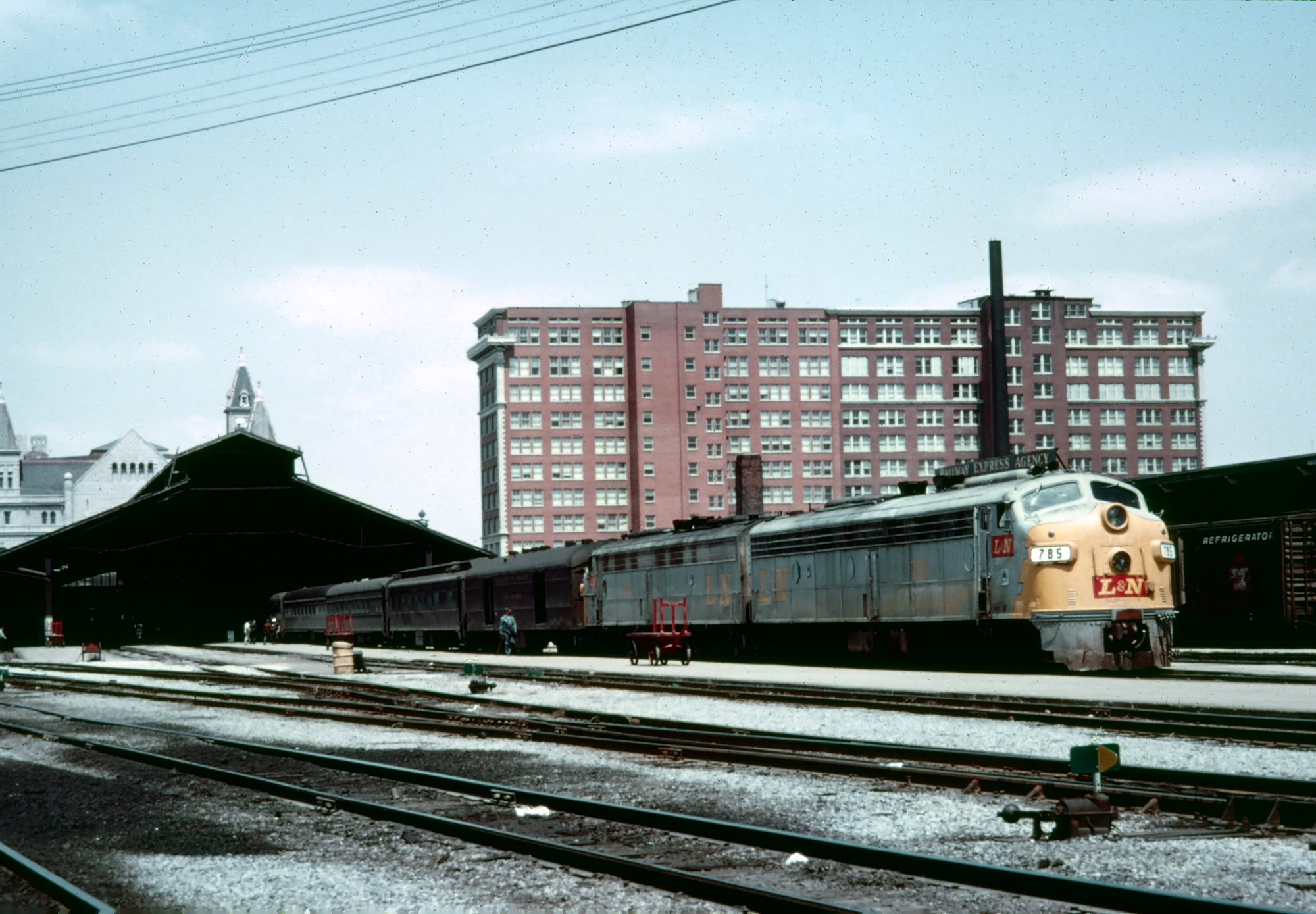 The final run of the "Pan American" as it awaits departure from Louisville Union Station, led by E8A #785, on May 1, 1971. American-Rails.com collection.
The final run of the "Pan American" as it awaits departure from Louisville Union Station, led by E8A #785, on May 1, 1971. American-Rails.com collection.Final Years
Still, while most of the L&N’s fleet had been canceled by the late 1960s, the American carried on until the end when Amtrak took over intercity passenger rail operations on May 1, 1971.
During the American's final years of operation it still retained sleeper service, an amenity quickly disappearing by the 1960s in the rail travel industry. According to the L&N's 1969 timetable a typical consist included 10-roomette, double-bedroom sleepers running the length of the route, reclining seat coaches, and a diner offering "complete meal service."
By this time the company's South Wind was its only intercity passenger train offering a nearly intact allotment of services (aside from parlors which had disappeared long ago) including sleepers, lounges, coaches, and even a grill car.
Sources
- Burns, A.J. and Dawson, Leslie. Official Guide Of The Railways And Steam Navigation Lines Of The United States, Porto Rico, Canada, Mexico, and Cuba, The. Volume 85. Issue 3. Pages 534-554. New York: National Railway Publication Company, 1952.
- Schafer, Mike. Classic American Railroads. Osceola: MBI Publishing, 1996.
- Schafer, Mike and Welsh, Joe. Streamliners, History of a Railroad Icon. St. Paul: MBI Publishing, 2003.
Recent Articles
-
Maryland's - Wine Tasting - Train Rides
Jan 15, 26 02:59 PM
This article delves into the enchanting world of wine tasting train experiences in Maryland, providing a detailed exploration of their offerings, history, and allure. -
Colorado's - Wine Tasting - Train Rides
Jan 15, 26 02:46 PM
To truly savor these local flavors while soaking in the scenic beauty of Colorado, the concept of wine tasting trains has emerged, offering both locals and tourists a luxurious and immersive indulgenc… -
Iowa ~ Wine Tasting ~ Train Rides
Jan 15, 26 02:36 PM
The state not only boasts a burgeoning wine industry but also offers unique experiences such as wine by rail aboard the Boone & Scenic Valley Railroad. -
Georgia's Wine Train Rides In Cordele!
Jan 15, 26 02:26 PM
While the railroad offers a range of themed trips throughout the year, one of its most crowd-pleasing special events is the Wine & Cheese Train—a short, scenic round trip designed to feel like a t… -
Indiana ~ Murder Mystery ~ Dinner Train Rides
Jan 15, 26 02:22 PM
This piece explores the allure of murder mystery trains and why they are becoming a must-try experience for enthusiasts and casual travelers alike. -
Ohio ~ Murder Mystery ~ Dinner Train Rides
Jan 15, 26 02:10 PM
The murder mystery dinner train rides in Ohio provide an immersive experience that combines fine dining, an engaging narrative, and the beauty of Ohio's landscapes. -
Nevada Dinner Train Rides In Ely!
Jan 15, 26 02:01 PM
If you’ve ever wished you could step through a time portal into the hard-working world of a 1900s short line the Nevada Northern Railway in Ely is about as close as it gets. -
Michigan Dinner Train Rides In Owosso!
Jan 15, 26 09:46 AM
The Steam Railroading Institute is best known as the home of Pere Marquette #1225 and even occasionally hosts a dinner train! -
Arizona's - Wine Tasting - Train Rides
Jan 14, 26 02:04 PM
For those who want to experience the charm of Arizona's wine scene while embracing the romance of rail travel, wine tasting train rides offer a memorable journey through the state's picturesque landsc… -
Arkansas's - Wine Tasting - Train Rides
Jan 14, 26 01:57 PM
This article takes you through the experience of wine tasting train rides in Arkansas, highlighting their offerings, routes, and the delightful blend of history, scenery, and flavor that makes them so… -
Tennessee ~ Murder Mystery ~ Dinner Train Rides
Jan 14, 26 01:42 PM
Amidst the rolling hills and scenic landscapes of Tennessee, an exhilarating and interactive experience awaits those with a taste for mystery and intrigue. -
California ~ Murder Mystery ~ Dinner Train Rides
Jan 14, 26 01:26 PM
When it comes to experiencing the allure of crime-solving sprinkled with delicious dining, California's murder mystery dinner train rides have carved a niche for themselves among both locals and touri… -
Illinois ~ Murder Mystery ~ Dinner Train Rides
Jan 14, 26 01:13 PM
Among Illinois's scenic train rides, one of the most unique and captivating experiences is the murder mystery excursion. -
Vermont's - Murder Mystery - Dinner Train Rides
Jan 14, 26 12:57 PM
There are currently murder mystery dinner trains offered in Vermont but until recently the Champlain Valley Dinner Train offered such a trip! -
Massachusetts Dinner Train Rides On Cape Cod!
Jan 14, 26 12:20 PM
The Cape Cod Central Railroad (CCCR) has carved out a special niche by pairing classic New England scenery with old-school hospitality, including some of the best-known dining train experiences in the… -
Maine Dinner Train Rides In Portland!
Jan 14, 26 11:31 AM
While this isn’t generally a “dinner train” railroad in the traditional sense—no multi-course meal served en route—Maine Narrow Gauge does offer several popular ride experiences where food and drink a… -
Kentucky Dinner Train Rides In Bardstown!
Jan 13, 26 01:14 PM
The essence of My Old Kentucky Dinner Train is part restaurant, part scenic excursion, and part living piece of Kentucky rail history. -
Kansas Dinner Train Rides In Abilene!
Jan 13, 26 12:44 PM
If you’re looking for a heritage railroad that feels authentically Kansas—equal parts prairie scenery, small-town history, and hands-on railroading—the Abilene & Smoky Valley Railroad (A&SV) delivers. -
Michigan ~ Murder Mystery ~ Dinner Train Rides
Jan 13, 26 11:24 AM
Among the lesser-known treasures of this state are the intriguing murder mystery dinner train rides—a perfect blend of suspense, dining, and scenic exploration. -
Virginia's - Murder Mystery - Dinner Train Rides
Jan 13, 26 11:11 AM
Among the state's railroad attractions, murder mystery dinner trains stand out as a captivating fusion of theatrical entertainment, fine dining, and scenic travel. -
Arizona Dinner Train Rides At The Grand Canyon!
Jan 13, 26 10:59 AM
While the Grand Canyon Railway does not offer a true, onboard dinner train experience it does offer several upscale options and off-train dining. -
Georgia Dinner Train Rides In Nashville!
Jan 13, 26 10:27 AM
If you’ve ever wished you could slow down, trade traffic for jointed rail, and let a small-town landscape roll by your window while a hot meal is served at your table, the Azalea Sprinter delivers tha… -
Indiana Valentine's Train Rides
Jan 12, 26 04:27 PM
If you’ve ever wished you could step into a time when passenger trains were a Saturday-night treat and a whistle echoing across farm fields meant “adventure,” the Nickel Plate Express delivers that fe… -
Ohio Valentine's Train Rides!
Jan 12, 26 04:20 PM
The Hocking Valley Scenic Railway offers one of the region’s most atmospheric ways to experience the Hocking Hills area: from the rhythmic click of jointed rail to the glow of vintage coaches rolling… -
Wisconsin's - Wine Tasting - Train Rides
Jan 12, 26 03:10 PM
Wisconsin might not be the first state that comes to mind when one thinks of wine, but this scenic region is increasingly gaining recognition for its unique offerings in viticulture. -
California's - Wine Tasting - Train Rides
Jan 12, 26 02:34 PM
This article explores the charm, routes, and offerings of these unique wine tasting trains that traverse California’s picturesque landscapes. -
Wisconsin Scenic Train Rides In North Freedom!
Jan 12, 26 02:20 PM
The Mid-Continent Railway Museum is a living-history museum built around the sights, sounds, and everyday rhythms of small-town and shortline railroading in the early 20th century, what the museum cal… -
Vermont Scenic Train Rides In Burlington!
Jan 12, 26 01:18 PM
Today, GMRC is best known by many travelers for its Burlington-based passenger experiences—most famously the Champlain Valley Dinner Train and the sleek, limited-capacity Cocktails on the Rails. -
Maryland's - Murder Mystery - Dinner Train Rides
Jan 12, 26 01:03 PM
Maryland is known for its scenic landscapes, historical landmarks, and vibrant culture, but did you know that it’s also home to some of the most thrilling murder mystery dinner trains? -
Minnesota's - Murder Mystery - Dinner Train Rides
Jan 12, 26 12:17 PM
Murder mystery dinner trains offer an enticing blend of suspense, culinary delight, and perpetual motion, where passengers become both detectives and dining companions on an unforgettable journey. -
Vermont Dinner Train Rides In Burlington!
Jan 12, 26 12:09 PM
There is one location in Vermont hosting a dedicated dinner train experience at the Green Mountain Railroad. -
Connecticut Dinner Train Rides In Essex!
Jan 12, 26 10:39 AM
Connecticut's rail heritage can be traced back to the industry's earliest days and a few organizations preserve this rich history by offering train rides. The Essex Steam Train also hosts dinner-theme… -
Florida Scenic Train Rides In Parrish!
Jan 11, 26 10:26 PM
The Florida Railroad Museum (FRRM) in Parrish offers something increasingly rare in today’s rail landscape: a chance to ride historic equipment over a surviving fragment of an early-20th-century mainl… -
California's - Wine Tasting - Train Rides
Jan 11, 26 02:28 PM
This article explores the charm, routes, and offerings of these unique wine tasting trains that traverse California’s picturesque landscapes. -
Georgia's - Murder Mystery - Dinner Train Rides
Jan 11, 26 02:07 PM
In the heart of the Peach State, a unique form of entertainment combines the thrill of a murder mystery with the charm of a historic train ride. -
Colorado ~ Murder Mystery ~ Dinner Train Rides
Jan 11, 26 01:43 PM
Nestled among the breathtaking vistas and rugged terrains of Colorado lies a unique fusion of theater, gastronomy, and travel—a murder mystery dinner train ride. -
Minnesota Dinner Train Rides In Duluth!
Jan 11, 26 01:32 PM
One of the best ways to feel the region's history in motion today is aboard the North Shore Scenic Railroad (NSSR), which operates out of Duluth’s historic depot. -
Illinois Dinner Train Rides At Monticello!
Jan 11, 26 12:42 PM
The Monticello Railway Museum (MRM) is one of those places that quietly does a lot: it preserves a sizable collection, maintains its own operating railroad, and—most importantly for visitors—puts hist… -
Alabama's - Wine Tasting - Train Rides
Jan 10, 26 09:29 AM
While the state might not be the first to come to mind when one thinks of wine or train travel, the unique concept of wine tasting trains adds a refreshing twist to the Alabama tourism scene. -
Maryland Dinner Train Rides At WMSR!
Jan 10, 26 09:13 AM
The Western Maryland Scenic Railroad (WMSR) has become one of the Mid-Atlantic’s signature heritage operations—equal parts mountain railroad, living museum, and “special-occasion” night out. -
Arkansas Dinner Train Rides On The A&M!
Jan 10, 26 09:11 AM
If you want a railroad experience that feels equal parts “working short line” and “time machine,” the Arkansas & Missouri Railroad (A&M) delivers in a way few modern operations can. -
South Dakota's - Murder Mystery - Dinner Train Rides
Jan 10, 26 09:08 AM
While the state currently does not offer any murder mystery dinner train rides, the popular "1880 Train" at the Black Hills Central recently hosted these popular trips! -
Wisconsin's - Murder Mystery - Dinner Train Rides
Jan 10, 26 09:07 AM
Whether you're a fan of mystery novels or simply relish a night of theatrical entertainment, Wisconsin's murder mystery dinner trains promise an unforgettable adventure. -
Missouri's - Murder Mystery - Dinner Train Rides
Jan 10, 26 09:05 AM
Missouri, with its rich history and scenic landscapes, is home to one location hosting these unique excursion experiences. -
Washington ~ Murder Mystery ~ Dinner Train Rides
Jan 10, 26 09:04 AM
This article delves into what makes murder mystery dinner train rides in Washington State such a captivating experience. -
Kentucky Scenic Train Rides At KRM!
Jan 09, 26 11:13 PM
Located in the small town of New Haven the Kentucky Railway Museum offers a combination of historic equipment and popular excursions. -
Washington "Wine Tasting" Train Rides
Jan 09, 26 08:53 PM
Here’s a detailed look at where and how to ride, what to expect, and practical tips to make the most of wine tasting by rail in Washington. -
Kentucky's - Wine Tasting - Train Rides
Jan 09, 26 08:21 PM
Kentucky, often celebrated for its rolling pastures, thoroughbred horses, and bourbon legacy, has been cultivating another gem in its storied landscapes; enjoying wine by rail. -
Kentucky's - Murder Mystery - Dinner Train Rides
Jan 09, 26 01:12 PM
In the realm of unique travel experiences, Kentucky offers an enchanting twist that entices both locals and tourists alike: murder mystery dinner train rides. -
Utah's - Murder Mystery - Dinner Train Rides
Jan 09, 26 01:05 PM
This article highlights the murder mystery dinner trains currently avaliable in the state of Utah!

